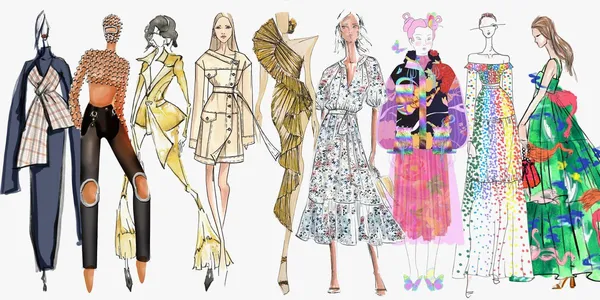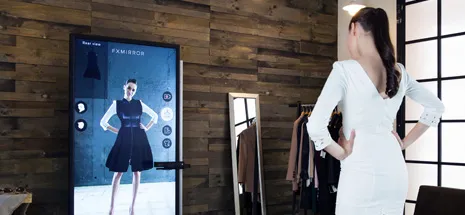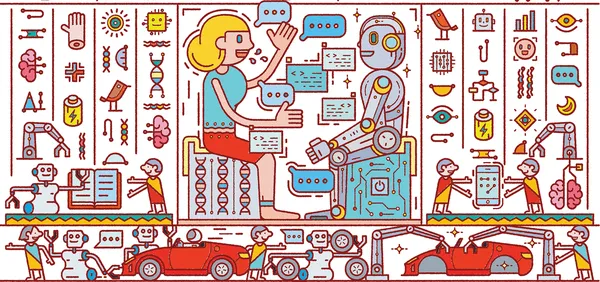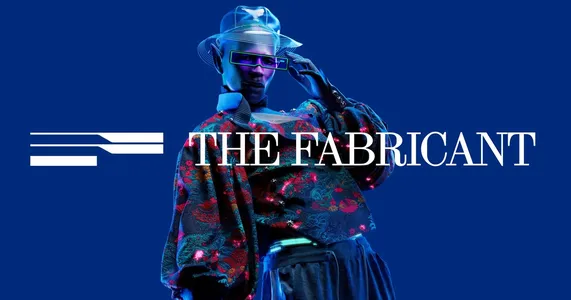Introduction
Fashion Forward with Generative AI embarks on a journey of creative synergy. It is revealing a new era where technology and fashion converge. This blog reveals Generative AI’s dramatic impact on fashion, promoting limitless innovation, individualized experiences, and sustainable practices. The perspective broadens through bespoke designs and trend forecasting, changing the essence of fashion. This progression embraces ethical design and sustainability, giving new life to environmentally beneficial methods. Generative AI emerges as a driving force behind a sustainable fashion revolution, embracing innovative materials, waste reduction, and circular fashion to reimagine the industry’s future.

Learning Objectives
- Gain insights into Generative AI’s transformative influence on the fashion industry.
- Enhance your understanding of Virtual Couture and its revolutionary potential in fashion design by exploring generative AI.
- Explore the synergy of human creativity and AI innovation within the fashion industry. Uncovering the transformative potential of collaborative design.
This article was published as a part of the Data Science Blogathon.
Table of contents
The Power of Generative AI in Fashion
Generative AI surpasses traditional limits, altering the fashion industry in the realm where aesthetics meet innovation. Generative AI is a manifestation of computational creativity. It works as a complex symphony of algorithms and neural networks. It absorbs patterns, styles, and data from various sources to produce new and inventive outputs in fashion, where individuality and self-expression reign supreme. Generative AI provides an unequaled aspect of originality.
This technology enables designers to make aesthetically beautiful and highly personal apparel that resonates with each wearer’s essence. Furthermore, we delve into the symbiotic link between Generative AI and the greater fashion industry. As fashion firms strive to differentiate in an increasingly competitive market. Generative AI catalyzes creativity, allowing brands to create collections that captivate attention and elicit intrigue. The technology provides a platform for experimentation, pushing designers to push the limits of convention and venture into unexplored territory.

Practical Applications of Generative AI
The practical applications of Generative AI go far beyond aesthetics. Designers who use AI-powered tools go on a path of streamlined creativity and rapid iteration. Design processes, such as brainstorming and iteration, are sped up, allowing designers to devote more time to perfecting their artistic vision. This symbiotic relationship between human inventiveness and computer capability fosters an atmosphere in which creativity thrives. Results in the production of designs that are not only visually appealing but also philosophically profound. However, as we negotiate the revolutionary potential of Generative AI in fashion, we must confront the ethical concerns that come with this digital revolution. We discuss creative ownership and the designer’s role in an AI-assisted creative process.
Virtual Couture: Creating Unique Garments
In a world where fashion is more than simply a means of self-expression but also a platform for innovation. Generative AI emerges as a game-changing technology that is transforming the very nature of couture. The barriers between artistry and technology blur, ushering in a new era of individualized fashion.
Consider the following scenario: a designer envisions a one-of-a-kind dress matched to a person’s personality, body shape, and stylistic preferences. Generative AI enters the creative collaborator, leveraging massive amounts of information, trends, and design principles to develop many design alternatives. These variants serve as the foundation for really unique artwork.
import generative_ai #Load a pre-trained Generative AI model
model= generative_ai.load_model('fashion_generator_model') #Define personalized input
personal_style = { 'color': 'royal blue', 'silhouette': 'A-line', 'embellishments': ['floral lace', 'beading'], 'length': 'floor-length'
} # Generate design variations based on personalized style
design_variations = model.generate_designs (personal_style) # Present design options to the designer
for index, design in enumerate(design_variations): print(f"Design Option {index + 1}: {design}")

Trend Forecasting and Style Exploration
In the ever-changing world of fashion, staying ahead of the curve is more than a hobby; it’s an art form. The intersection of aesthetics and market dynamics necessitates a keen sense of anticipation. Generative AI is a revolutionary technology that has changed trend forecasting and style exploration. Moving the fashion industry into a future where innovation and intuition coexist effortlessly.
Trend forecasting, previously reliant on historical data and human intuition, now has a powerful ally in Generative AI. With its ability to analyze massive volumes of data and discover small patterns, this technology has reshaped the landscape of anticipating what’s next. AI models provide projections for designers, companies, and fashion fans by evaluating prior patterns, consumer habits, and societal shifts.
#Load trend forecasting AI model
trend_model=generative_ai.load_model('fashion_trend_forecaster') #Forecast fashion trends for the upcoming season
upcoming_trends=trend_model.forecast_trends('Fall/Winter 2023') #Print the forecasted trends
print("Forecasted Terends for Fall/Winter 2023: ")
for trend in upcoming_trends: print("- "+ trend)
Beyond forecasting, Generative AI enables designers to engage in compelling style exploration expeditions. AI models generate various design possibilities that push the frontiers of creativity by inputting various design elements, themes, or inspirations. This dynamic approach allows Designers to explore unexplored aesthetic landscapes and develop novel combinations.
#Load style exploration AI model
style_model=generative_ai.load_model('style_explorer') #Define design elements and themes for exploration
design_theme={ 'colors':['muted pastels','earthy tones'], 'textures': ['velvet','tweed'], 'patterns': ['geometric','floral'],
} #Generate style variations based on the design theme
style_variations=style_model.explore_style(design_theme) #Present style options to the designer
for index,style in enumerate(style_variations): print(f"Style Option {index + 1}: {style}")
Sustainable Fashion Revolution
In an increasingly environmentally conscious society, the fashion industry is undergoing a fundamental transition that puts sustainability at the heart of design. Enter Generative AI, a disruptive force driving a sustainable fashion revolution. This chapter digs into Generative AI’s crucial role in transforming the fashion design landscape, enabling a paradigm shift toward ethical practices, mindful consumption, and peaceful coexistence with the world.
Sustainability in fashion goes well beyond aesthetics; it includes responsible material selection, waste reduction, and the development of goods that benefit both wearers and the environment. Generative AI, with its data-processing abilities, plays a revolutionary role in this revolution by assisting designers in making ethical and environmentally conscious decisions.
Consider the material selection process an important part of sustainable fashion. Designers have always had to navigate a complex web of material possibilities, each with its own environmental footprint. This procedure is simplified by generative AI, which analyzes a large amount of data, such as material qualities, sourcing origins, and environmental impact. AI helps designers make clothing that meets aesthetic standards and corresponds with sustainability goals by producing optimal material combinations based on these parameters.
# Load sustainable material selection AI model
sustainability_model = generative_ai.load_model('sustainable_material_selector') # Define design requirements and sustainability criteria
design_requirements={ 'color': 'natural tones', 'texture': 'soft', 'durability': 'high',
} # Generate sustainable material options based on requirements
sustainable_materials = sustainability_model.select_materials (design_requirements) # Present sustainable material options to the designer
print("Sustainable Material Options: ")
for index, material in enumerate(sustainable_materials): print(f"Option (index + 1): (material)")
Furthermore, the sustainable fashion revolution assisted by Generative AI includes waste reduction and promoting circular fashion practices. AI-driven design optimization reduces material waste by generating patterns that maximize fabric consumption. Furthermore, Generative AI can help to create modular and flexible designs that allow clothing to be repurposed or modified over time, embracing the ideas of circular fashion.
Textile Innovation and Pattern Generation
Textiles are the essential basis upon which creative expression is woven in the complicated tapestry of fashion design. Generative AI emerges as a trailblazing force at the confluence of tradition and technology, pushing a paradigm shift in textile innovation and pattern development. Textile design, a field where beauty and technical accuracy meet, has found a dynamic collaborator in Generative AI. This cutting-edge technology, immersed in the intricacies of data analysis and pattern recognition, enables designers to explore unknown realms of textile aesthetics, unleashing a symphony of creativity that resonates profoundly with wearers. AI models may develop an assortment of appealing patterns that catch the eye and elicit emotion by consuming a wide range of influences, from historical patterns to contemporary inspirations.
# Load AI model for textile pattern generation
pattern_model = generative_ai.load_model('textile_pattern_generator') # Define design parameters and inspirations
design_parameters = { 'color palette': ['vibrant', 'pastel'], 'theme': 'floral fantasy', 'complexity': 'high', } # Generate textile patterns based on design parameters
textile_patterns = pattern_model.generate_patterns (design_parameters) # Present generated textile patterns to the designer
for index, pattern in enumerate(textile_patterns): print("Pattern {index + 1}: {pattern}")
Furthermore, the impact of Generative AI goes beyond traditional patterns. It allows designers to go into parametric design, in which mathematical procedures sculpt fabrics. This heralds a new age in fabric manipulation, allowing designers to create textiles that morph, adapt, and respond to various stimuli.
As we travel around the textile innovation landscape, it becomes clear that Generative AI can change the very texture of fashion. AI inspires a rebirth of creativity by infusing fabrics with a symphony of patterns, textures, and designs that transcend convention. This symbiotic link between human brilliance and computational artistry creates a harmonious balance that propels textile design to new heights.
Virtual Fitting Rooms and Augmented Reality
Fashion fundamentally transforms in an age where digital realms intersect with physical experiences. Enter Generative AI, a trailblazing force altering how we engage with apparel through virtual fitting rooms and augmented reality (AR). This chapter takes the reader on a tour through the enthralling marriage of technology and fashion, where Generative AI breathes life into digital clothes and improves the consumer experience in unprecedented ways. Virtual fitting rooms and augmented reality are innovative pillars transforming the fashion industry. Trying on clothes used to be limited to the limits of physical stores.
With Generative AI at the helm, this process has moved beyond its usual boundaries, allowing consumers to try on items and experiment with trends virtually. The concept of digital garments—virtual reproductions of real clothing items that can be placed onto a user’s image—is at the heart of this revolution. Generative AI is crucial in creating these digital clothes, ensuring they adhere to precise sizes, drapes, and movements. AR technology, which seamlessly incorporates this digital clothing into a user’s real-world environment, is at the heart of this change.

import augmented_reality as ar # Load AI model for digital garment creation
garment_model = generative_ai.load_model('digital_garment_creator') # User's body measurements for accurate fitting
user_measurements = { 'chest': 92, 'waist': 72, 'hips': 100,
} # Generate a digital garment based on users measurements and style preferences
digital_garment = garment_model.create_digital_garment(user_measurements, 'evening gown') # Integrate digital garment into augmented reality environment
ar_scene = ar.load_scene('virtual_fitting_room')
ar_scene.add_digital_garment(digital_garment)
ar_scene.display()
Collaborative Design: Humans and AI Creating Together
A symbiotic partnership has developed in the ever-changing fashion scene, mixing human genius with the algorithmic brilliance of Generative AI. This chapter explores the enthralling world of collaborative design, where designers and AI algorithms collaborate to create a creative symphony. Fashion takes on new dimensions due to this unprecedented cooperation, ushering in a disruptive era in which human expertise and AI creativity interweave to alter the very essence of design.

Collaborative design deviates from the traditional idea of technology as a solo instrument. Instead, it depicts AI as a collaborative companion, a co-creator who augments and supplements human creativity. Combining human intent with AI-generated possibilities is at the heart of collaborative design. Designers provide their vision, input parameters, and limitations, and Generative AI evaluates this data to generate a variety of design possibilities. This dynamic interchange encourages designers to connect with AI-generated designs, enhance their vision, and iterate toward a final masterpiece.
Moreover, collaborative design transcends the realm of aesthetics. It catalyzes ideation, problem-solving, and experimentation. By presenting designers with diverse AI-generated options, collaborative design stimulates lateral thinking and encourages exploration beyond conventional boundaries. The transformative power of collaborative design extends beyond the creative process—it impacts the nature of design ownership. The chapter delves into the nuanced landscape of authorship and ownership, addressing ethical considerations surrounding AI-generated designs. It explores the delicate interplay between human inspiration and AI contribution, fostering a deeper understanding of the collaborative design ecosystem.
Designing Accessories and Beyond
The limelight in the ever-changing fashion world is not limited to garments alone. Accessories, those fine details that adorn and elevate an ensemble, are now taking center stage in a world of innovation powered by Generative AI. This chapter ventures into unknown territory, going beyond traditional bounds to see how Generative AI is transforming the landscape of accessory design and broadening the horizons of creative expression. Accessories have always been associated with personal style, serving as a canvas for self-expression in addition to clothing. Thanks to Generative AI as a visionary partner, designers now have a new tool to reinvent accessories in previously unimaginable ways. From jewelry to handbags, footwear to headpieces, Generative AI infuses these accoutrements with a symphony of innovation, turning them into focal points of artistic ingenuity.
The impact of Generative AI goes beyond aesthetics; it changes the basic foundation of accessory design operations. AI models are excellent partners throughout the design cycle because they speed up ideation, enable rapid prototyping, and encourage iterative exploration. We see the emergence of a realm where creativity knows no limitations as we travel through the landscapes of accessories and beyond. The collaboration of human ingenuity with AI-driven innovation yields accessory ideas that captivate, intrigue, and reflect the pulsating heart of modern fashion.
The Future of Fashion with Generative AI
As we approach the dawn of a new era, the convergence of fashion and technology heralds a future with limitless possibilities. In this final part, we look ahead, imagining the disruptive impact that Generative AI will continue to have in the fashion industry. This part acts as a compass, guiding us through the unexplored territories of tomorrow’s fashion environment, where human ingenuity and AI innovation intersect to form an imaginative and deep future.
The future of fashion using Generative AI will be defined by a seamless fusion of tradition and innovation. AI-powered design tools have already begun democratizing creativity by allowing people from all walks of life to engage in the design process. Traditional limits no longer constrain designers, artists, and fashion fans. Instead, they can access many AI-generated possibilities that act as springboards for their imagination and inspiration.
One of the most intriguing possibilities is hyper-personalization. With massive datasets and awareness, generative AI will catapult fashion towards an era when every garment and accessory is tailor-made to reflect the wearer’s distinct personality.
Generative AI will continue to drive environmentally responsible design by optimizing material utilization, decreasing waste, and encouraging circular fashion practices. Designers will embrace AI-generated solutions that combine aesthetics and ethics, allowing them to design collections that leave a positive environmental footprint.
The future also promises increased interaction and engagement. Virtual fitting rooms and augmented reality experiences will evolve. It provides consumers with immersive and dynamic methods to explore fashion, try on items virtually, and engage with companies.
Case Studies: Real-Life Applications
- Reinventing Classic Elegance– In this first case study, a well-known fashion brand uses Generative AI to reimagine classic elegance. The design team uses AI algorithms to give timeless forms a modern spin. The AI model develops designs that pay attention to heritage while embracing cutting-edge aesthetics by incorporating historical fashion archives and new design influences. As a result, the collection speaks to the brand’s past and the evolving tastes of a new generation.
- Sustainable Innovation– The second case study explores a sustainable fashion brand’s ambition to use Generative AI to change material procurement. AI models support the company in creating a range of sustainable textiles and trimmings by assessing ecological footprints, material qualities, and consumer needs. This data-driven methodology enables designers to create collections consistent with the brand’s conscious consumption attitude. Human ingenuity combined with AI-driven insights results in a collection that dazzles the runway and represents a dedication to the environment.
- Customization Redefined– In our final case study, a direct-to-consumer fashion label uses Generative AI to redefine customization. The brand launched an interactive portal where customers may input their preferences, body measurements, and stylistic preferences. Generative AI works with each person to create individualized designs representing their personalities. This customization path increases consumer involvement, builds emotional ties, and blurs the gap between designer and wearer.
Each case study demonstrates Generative AI’s incredible adaptability in fashion, demonstrating its ability to empower designers, advance sustainability, and form stronger ties with consumers. These stories exemplify the intersection of creativity and technology, revealing how Generative AI is not a far-off vision of the future but a palpable force affecting the present and paving the path for a visionary tomorrow.
Concrete Implementation of Generative AI
The Fabricant is at the vanguard of the digital revolution in the fashion business, exemplifying the unique marriage of art, technology, and innovation. At its core, the Fabricant redefines the fundamental essence of fashion by pioneering the use of generative AI in apparel creation. This avant-garde digital fashion house operates in a world where garments exist solely in the digital domain yet have a powerful impact on a global audience. The Fabricant’s creations are powered by generative AI, which uses complex algorithms to create intricate and fully virtual clothing pieces. This method allows designers to create clothing beyond the constraints of actual textiles and materials. Instead, AI interprets design concepts, creates complicated patterns, and replicates richly detailed and visually appealing materials.
The Fabricant in Action
The Fabricant’s generative AI allows it to venture into unexplored design territory, where inventiveness has no limitations. Each piece of clothing serves as a canvas for the AI to weave an innovative tapestry. Mixing strange motifs and fine details that are difficult to produce using traditional methods.

The Fabricant’s design process has been influenced by generative AI in ways other than aesthetics. It speeds up design iterations, allowing for faster experimentation and creative innovation. The Fabricant’s team works as co-creators with AI, refining and iterating on designs to create a harmonious blend of human insight and technological prowess. Furthermore, The Fabricant’s digital clothes transcend the temporal character of physical fashion, resonating in the digital and virtual realms. These digital designs thrive outside the confines of a runway in social media, virtual worlds, and immersive experiences.
The Fabricant reimagines fashion as a constantly evolving narrative, and generative AI is its storytelling tool. The Fabricant ushers in a new era of fashion by embracing technology and pushing the frontiers of design, tantalizing the senses, challenging norms, and transforming how we see clothing in the digital age. In this digital couture realm, generative AI allows The Fabricant to design garments that live outside of threads and seams, embodying a new paradigm in which imagination reigns supreme.
Conclusion
In conclusion, we are on the verge of a fashion renaissance marked by infinite possibilities and innovative research. The trip continues, and we negotiate the ever-changing terrain of Generative AI and fashion with curiosity, wonder, and joy.
Key Takeaways
- Generative AI revolutionizes creative expression by enabling designers to effortlessly generate unique and innovative designs, pushing the boundaries of traditional fashion concepts.
- With generative AI, fashion becomes a personalized experience like never before.
- Generative AI provides new tools for artisans to experiment and evolve their skills. It leads to a harmonious blend of human expertise and technological innovation in the fashion landscape.
- Integrating generative AI into the fashion workflow streamlines the design process, reducing time and material wastage.
Frequently Asked Questions
A. Generative AI is an innovative technology that uses ML algorithms to generate new and creative content. It is revolutionizing the fashion industry, from creating unique clothing patterns, to trend forecasting and enabling virtual try-on experiences.
A. Virtual fitting rooms use augmented reality (AR) to allow users to try on clothing and accessories virtually. Generative AI enhances this experience by generating accurate digital replicas of garments that can be superimposed onto a user’s image. This lets consumers visualize how different items will fit and look before purchasing.
A. Collaborative design involves designers and AI algorithms working together to create innovative designs. Generative AI takes input from designers’ visions and preferences to generate various design options. This collaborative process sparks creativity, encourages experimentation, and helps designers explore new aesthetic directions.
The media shown in this article is not owned by Analytics Vidhya and is used at the Author’s discretion.
Related
- SEO Powered Content & PR Distribution. Get Amplified Today.
- PlatoData.Network Vertical Generative Ai. Empower Yourself. Access Here.
- PlatoAiStream. Web3 Intelligence. Knowledge Amplified. Access Here.
- PlatoESG. Automotive / EVs, Carbon, CleanTech, Energy, Environment, Solar, Waste Management. Access Here.
- PlatoHealth. Biotech and Clinical Trials Intelligence. Access Here.
- ChartPrime. Elevate your Trading Game with ChartPrime. Access Here.
- BlockOffsets. Modernizing Environmental Offset Ownership. Access Here.
- Source: https://www.analyticsvidhya.com/blog/2023/08/fashion-forward-with-generative-ai/



